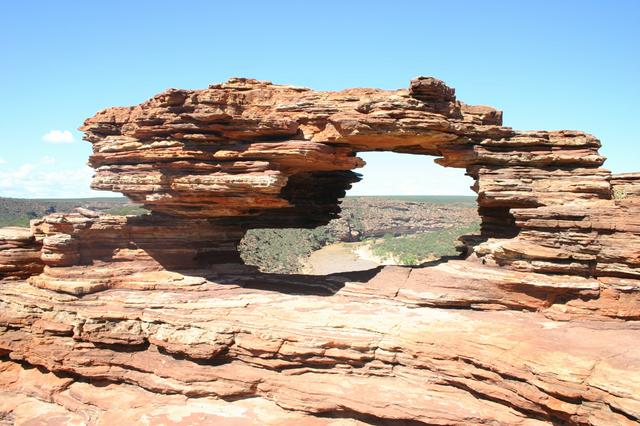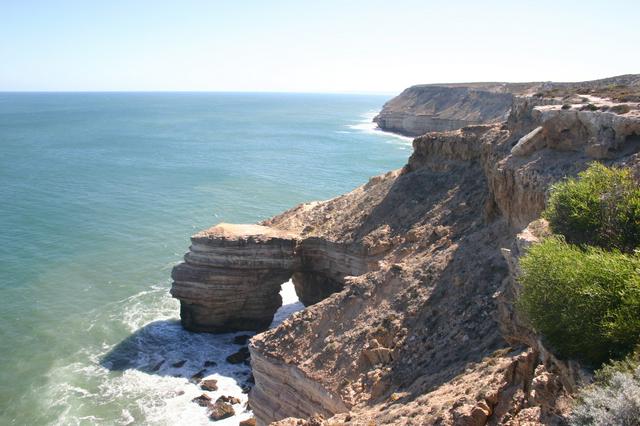 Kalbarri National Park is in the Mid West region of Western Australia 485 km (301 mi) north of Perth. The main geographical feature of Kalbarri National Park is the Murchison River gorge. The landscape has been carved out by the Murchison River and leads out to the Indian Ocean where spectacular cliffs are the result of erosion from both the river and ocean.
Kalbarri National Park is in the Mid West region of Western Australia 485 km (301 mi) north of Perth. The main geographical feature of Kalbarri National Park is the Murchison River gorge. The landscape has been carved out by the Murchison River and leads out to the Indian Ocean where spectacular cliffs are the result of erosion from both the river and ocean.
Kalbarri is an aboriginal name, but the origin and meaning have been lost. It is not known exactly where the name comes from. Some sources claim it means ‘seed’ or ‘woody pear’ in the dialect of the local Aborigines, other sources cite it as being the name of an important member of the Murchison tribe.
The local Aboriginal people have inhabited this land for thousands of years. The Murchison River and Murchison River gorge are wind through the landscape forming many bends and unique winding shapes. The Aborigines have a dreaming story about the Rainbow Serpent forming the Murchison River because of the unique shape. For many years Kalbarri went unsettled by Europeans because many explorers and would-be settlers shipwrecked near the Kalbarri coast. In the 1940s fishermen and miners started to settle the area before it was finally made an official city. Kalbarri was declared a towns site by the state government in 1948. Kalbarri National Park was gazetted in 1963. Now Kalbarri National Park and the Kalbarri region is mostly known as a popular tourist destination. Visit the Kalbarri National Park visitors centre for current weather alerts, calendar of events, and to see what’s on.
The national park covers an area of 183,004 hectares. The Murchison River is the second longest river in Western Australia. It is 820 km long with the last 80 km of the river carving the Murchison River gorge and located in Kalbarri National Park. There are several notable lookouts and landmarks along the gorge including Nature’s Window, Z-Bend, and the Natural Bridge.
Wildflowers are abundant in Kalbarri and the region is known for is beautiful blooming wildflowers. During wildflower season from July to October over 1,000 species of Western Australian wildflowers bloom. Western Australia has the largest variety of wildflowers in the world. Sixty per cent of the wildflowers in Western Australia are not found anywhere else on Earth. Te wild flowers seen here are unique to the region and cannot be found anywhere else including the yellow of red Kalbarri Catspaw, the Kalbatti spider orchid, and the Murchison hammer orchid. During wildflower season Kalbarri National Park goes through a transformation in which it appears to have a carpet of wildflowers. The view and the scent are both magnificent to behold.
Bird watching is a popular pastime in the Kalbarri region which supports about 200 bird species. Different bird species can be spotted in the different sections of Kalbarri National Park and they include the Eastern Osprey, the White-bellied Sea-eagle, Southern Scrub-robin, Redthroats, Variegated Frairy-wren, Rock Parrots,wedge-tailed eagles, Emus, Australian Bustards, Peregrine Falcon, Common Bronzewing, and Splendids just to name some of the specific breeds you can see within the park. Then there are many other types of birds including honeyeaters, ospreys, cockatoos, parrots, doves, ducks, waders, gulls, cormorants, and pelicans. Many of the animals that inhabit the area are nocturnal mammals. Some of the notable animals to look for are the western grey kangaroo, thorny devils, and the tammar wallaby.
Summer temperatures frequently exceed 40°C in the inland part of the park. During this time the temperature in the upper section of the park can often be more than 10°C higher than in the town of Kalbarri. Most of the rainfall is between May and August
National Park Passes are a per-vehicle rate and are available for a day pass, holiday pass, or annual pass.
There are many beautiful sights to see in Kalbarri National Park. Some of the most photographed spots in the world are here including Nature’s Window, The Loop, and the Natural Bridge.

- The Loop Lookout
- Nature’s Window
- Z-Bend Lookout
- Hawk’s Head
- Ross Graham Lookout
- Wildflowers during season from July to October.
- Mushroom Rock
- Meanarra Hill
- Red Bluff
- Eagle Gorge
- Rainbow Valley
- Rot Alley
- Shellhouse and Grandstand
- Island Rock
- Natural Bridge
- Fishing (both fresh water on the Murchison River and Salt Water in the Indian Ocean)
- Surfing
- Sandboarding
- Skydiving
- Whale Watching
- Bushwalking
- Boating
There are several picnic spots set up within the park for a picnic with nature.
Hawk’s Head is one of the top picnic spots in the park. It sports a new look out over the Murchison River gorge and is easy to get to and wheelchair accessible.
Drinking water is not available in the park, so be sure to bring plenty of your own fresh drinking water. During hot conditions, it’s recommended that you allow 3 to 4 litres of water per person per day.
Please observe all rules on park signs and brochures. Stay clear of cliff edges and overhangs – always keep to the paths and lookouts where provided. Sturdy footwear, a hat, sunscreen and insect repellent are essential to ensuring your comfort and safety while exploring the park. Check the weather forecast before heading out into the park.
When dealing with Aboriginal people, there are some cultural considerations to remember:
- Some Aboriginal people have beliefs that mean they don't like having their photo taken. It is courteous to ask for permission first.
- Family business and ceremonies are an important part of life for Aboriginal people and these matters take priority, which can interrupt scheduled tours.
- Access to some sites with spiritual significance may be restricted.
- If travelling north - the Shark Bay World Heritage area
- If travelling south - Geraldton
